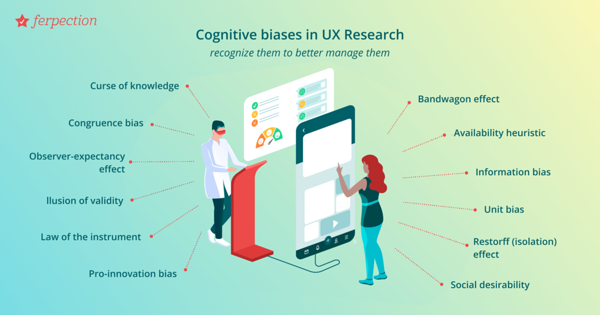June 14, 2022
How cognitive biases are used in UX Research
Basic principles of cognitive bias
Cognition refers to the mental processes involved in everything related to an individual's knowledge. Intelligence, reasoning, memory, perception, attention, as well as learning, problem-solving and decision-making are all fields that concern it. All deviations from the logical (standard) scheme of information processing are called “bias”.
Different types of thinking biases
Since the concept was first brought to light in the 1970s by cognitive psychologists Daniel Kahneman and Amos Tversky, the list of cognitive biases identified (currently around 200) has continued to grow. They are grouped under different categories that demonstrate above all that all levels of cognition processes are concerned. Thus, we find:
- judgmental biases, which assign value to elements in a subjective manner
- reasoning biases, which sort factors according to whether or not they reinforce a choice
- attentional biases, such as when we evade or focus on a piece of data according to arbitrary criteria
- memory biases, which prioritize the information in memory in a way that is specific to each person
- personality-related biases, such as attributing specific traits to oneself
- sensory-motor biases, pertaining to the illusion of perception
What is presented as a kind of unconscious dysfunction of our brain, distancing us from reality, has however its utility.
Friends or enemies? Reason for cognitive biases
The brain, in order to guarantee our survival, performs a permanent benefit-risk calculation to keep us at an acceptable level of safety. To this end, it continually assesses two types of factors:
- external, i.e. the environment
- internal emotions and sensations
Based on its analysis, it provides the most appropriate response. To facilitate its work and thus save its resources in time and energy, it finds tricks such as classification, comparison or selection. What we call cognitive biases are actually shortcuts in thinking that aim to lighten mental processes. The ultimate goal is to offer us optimal protection against stressful situations.
Now that this rapid, automatic and unconscious functioning of human thought is well known, it must be admitted that it can be diverted from its role of safeguard. This is probably why cognitive biases are almost invariably presented in a negative light, usually accompanied by advice about de-biasing or mitigating what is considered a “flaw”. Advertising indeed plays a lot with seen and reviewed processes such as:
- the anchor bias which shows the price before announcing the discounted price in order to reinforce the “good deal” effect
- the fear of losing or missing out, also called FOMO (Fear Of Missing Out), which can be reinforced by the display of a countdown before the promotion end, as we see very often on the internet
- the authority bias that gives more weight to what a figure identified as legitimate says (even if the person just wears a lab coat)
- etc.
But this is where the question of ethics comes in. Isn't marketing about delivering the right product, at the right price, to the right person, at the right time? What about customer satisfaction and brand image if certain psychological levers have been abused to push people to buy? This is where user experience research as envisioned by Ferpection takes cognitive biases into account. They are no longer seen as a loophole to be exploited, but rather as an inescapable process that has a reason to exist.
The main thinking biases that UX research faces
Rather than struggling with a so-called anomaly in our ability to reason, it is better to deal with thinking biases as factual data. This is particularly useful, when trying to anticipate human behaviors, as is the case with UX researchers.
Some deceptive thought patterns of users
Keep in mind that UX optimization must simply facilitate the user's journey in the way that the user will have identified as beneficial. The cognitive load inherent in its engagement must therefore be reduced to its most comfortable level. It is clear that this purpose defines both cognitive bias and user experience research.
For example, we know from social psychology that the group effect weighs on us, social animals that we are. “If my peers are doing it, it must be good for me too” is a type of thinking that, while fallible, saves us from painful procrastination. That's why any social evidence (such as customer reviews and other testimonials) that show mass support for the service being presented creates a sense of trust in the prospect that can influence their decisions.
It is also well known that the availability bias leads the potential customer to trust the information that is immediately available, avoiding further and potentially conflicting investigations. It works in conjunction with the information bias, which overestimates the abundance of information, thinking that this validates the choice. From decision-making to action, it's all about consistency. And once a form of commitment to a process is initiated, the unity bias leads the individual to finish what they have started.
However, prior to the decision and action, cognitive biases are just as active in capturing attention. The isolation effect (also called Von Restorff effect) thus gives more impact to an element that stands out from the group to which it belongs. It is all the more effective if it is coupled with a weirdness effect (strangely detonating with the context in which it is situated) or even a humor effect, or an image superiority effect, which are also listed as cognitive biases.
Since every human being is affected by these erroneous thinking mechanisms, the UX researcher might as well not give in to the blind spot: one should be careful not to believe that their judgment is less biased than that of others.
Examples of cognition biases that may influence UX research professionals
In the context of UX research, investigators are confronted with several types of biases that can distort the results. Some still come from the observed or interviewed subject. For example, one must take into account the social desirability that leads any individual to present themselves in the best possible light. Thus, the behavior would adjust according to the expectations identified in the observer. It is therefore up to researchers to diversify their theoretical approaches, in order to move towards a more natural version of the actions they seek to analyze.
On the professional side (usually the UX research consultant), the curse of knowledge does not allow for the necessary hindsight to evaluate a situation. Indeed, an expert is bound to lose the ability to put themselves in the shoes of the novice. This is one of the main reasons why companies choose to outsource their UX research operations to Ferpection.
Finally, our teams also face cognitive biases specific to researchers, including:
- the congruence bias, which tends to focus on validating the original hypothesis rather than disproving it or testing alternative thinking
- the observational bias, which manipulates or interprets the data in the direction of confirming the hypothesis
- the illusion of validity (or the illusory truth effect) which overvalues the results obtained because they appear to be consistent
- the law of the instrument (or Maslow's hammer), which places excessive reliance on familiar tools and methods, ignoring new and more appropriate approaches
- the pro-innovation bias which gives exaggerated importance to what is innovative
- etc.
Taking into account the existence of all these cognitive biases makes it possible to put in place solutions to get closer to the truth of the facts. That's why we rely on an array of scientific methods to support our UX research, and always work in a team in order to have the essential distance for reflection.
Cognitive bias in UX Research is neither good nor bad. It is simply part of the data inherent in the experience. For a relatively objective analysis, it is essential to be aware of them and, above all, to recognize them, so that the research conclusions are as relevant as possible. Since everyone's reality is subject to subjective processes, human behavior must be studied with a careful mix of bypassing and facilitating thinking biases.
Are you as passionate about the subject as we are? Don't hesitate to subscribe below 👇 to our newsletter to receive more information!
All articles from the category: User research | RSS

